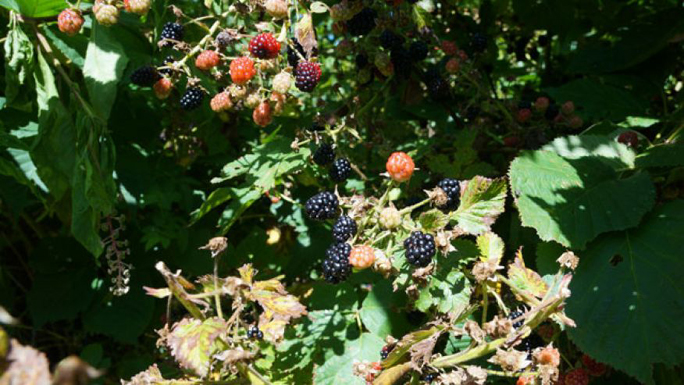Every year all over United States, parts of South America, Europe, Africa and Asia, blackberries fruit and ripen, often wild and untended, offering a luscious treat to anyone who will pick them. Oddly, the shiny black fruits are not actually berries, but technically “aggregate drupelets.” That is to say blackberries are composed of many little round fruit bodies containing seeds, all of them clustered together in the shape of a raspberry. Each fruit is more like a cluster of grapes than a single berry. Blackberries go by several other names, including brambleberries, dewberry, and thimbleberry, due to their thimble-like shape.
Blackberry fruits were widely used by various Native American tribes. The fruit was sometimes juiced and drunk; the berries were eaten fresh, and were also dried and stored for use in colder weather. Various native recipes for blackberries include mixing them with animal fat, with fish eggs, or preserved in grease. The preserved high-energy berries provided natural sugars and vitamins during winter months.
My wife and I have a large blackberry patch in our front yard, and have learned that complete neglect is what blackberries crave most. Do nothing to them at all and they develop profuse fruits promptly as summer comes to a close. Let them sit, uncut, with no attention, and they will eventually offer a riot of fruits. When there is ample rain during summer, production goes full tilt, and the bushes are especially heavily laden with fruits.
Blackberries are as super as any of the star super fruits, though they have received little red carpet attention. Like blueberries and acai, blackberries are loaded with potent antioxidants including anthocyanins, flavonoids, poylphenols, and cancer-fighting ellagic acid. In fact, in terms of sheer concentration of antioxidants, blackberries rank higher than almost any other North American foods. A 2006 study published in The American Journal of Clinical Nutrition, reported that blackberries’ antioxidant content is far above that of other foods. But unlike pomegranate or the more popular berries, they have received far less attention. Perhaps they don’t seem exotic enough, since they don’t come from the Amazon or Morocco. But pedigree aside, they are titans of protective, age-defying nutrition.
Blackberries grow on brambles, long slender canes adorned with small sharp prickles. If you wade into a blackberry patch, you’re going to get scratched up, unless you go for full protective gear including a jacket and gloves. Some serious blackberry pickers dress for the fruits as though for full battle, in needle-resistant gear, leather arm bands, and an array of silly pieces of clothing. As a regular blackberry picker, I think this is going way too far. For those who don’t care about a few scratches, blackberries offer a tart, sweet, richly-flavorful treat. Thornless cultivars have even been developed for those who can’t take the prickles. The fruits are good sources of vitamin E, contain some beneficial omega-3 fatty acids, and provide other vitamins and minerals as well.
Blackberries are cultivated in many parts of the world commercially, notably in Mexico, which leads the world in blackberry production. But they are also easily obtained in wild woodland areas, along streams and fields.
Perhaps one of the factors that has prevented blackberries from achieving superstar status is the quantity of seeds they contain. Each berry has dozens of crunchy little seeds, and not everyone enjoys this. But die-hard blackberry fans ignore the seeds, and in season will pile loads of them into a bowl for a healthy breakfast or snack.
Blackberries make excellent jams, and are a favorite of those who can preserves at home. The jam comes out deep, impenetrable bluish-purple, and is heavenly on toast.
Blackberries do not trumpet their presence. But they are super fruits. They offer a tart sweetness, and plenty of juice. Beware picking them in a white shirt, as the deep purple juice will dye fabric pretty much forever. Those caveats aside, blackberries deserve a place both in the kitchen and of super foods.


